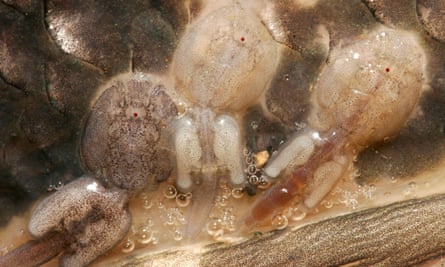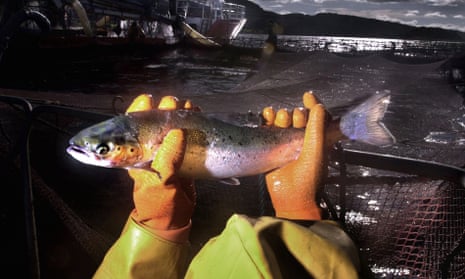You may never have heard of Lepeophtheirus salmonis, and you’re unlikely to have spotted one, because they are usually less than 1.5cm long, but the humble sea louse is creating waves that are about to wash on to your dinner plate.
Balanced on blinis, tucked into bagels or crafted into sushi, salmon has become an everyday luxury in the UK. But fans of seafood may be forced to take it off the menu as prices are expected to soar because of a surge in sea lice hitting production.
Wholesale salmon prices leapt as much as 50% last year after severe problems in Norway and Scotland with the tiny parasites, which feed on the blood and tissue of salmon. The problem followed a supply shortage caused by a deadly algae bloom in Chile, the world’s second biggest producer of farmed salmon.
Global supplies of Atlantic salmon fell nearly 9% last year and are expected to fall during the first half of this year as lice problems worsen, according to fish industry analysts at the Norwegian bank Nordea.
The top five salmon farms in Norway, the world’s largest producer of salmon, produced 60,000 tonnes less fish than expected last year, about a 6% drop, according to Nordea.
In Scotland, production dropped 4% to 171,722 tonnes in 2015. It was forecast to improve last year but the target is unlikely to be reached because of the sea lice and amoebic gill disease, a potentially fatal illness caused by another parasite, which arrived in the UK five years ago.
Both pests have become more common on fish farms in recent years, with experts blaming warming sea temperatures associated with climate change. The parasites– a tough marine cousin of the wood louse – attach themselves to the skin, fins or gills and feed on the fish.
One major international producer, Marine Harvest, said the volume of salmon it produced in Scotland had slumped by 16%, or 1,500 tonnes, in the summer, partly because it accidentally killed 175,000 fish while trying to treat them for lice using a device called a thermolicer.
The device, which immerses fish in a warm bath, is one of a number of methods fish farmers are trying to control sea lice as an alternative to chemicals. Other methods include the hydrolicer, which bathes fish in fresh water, and employing “cleaner fish” such as wrasse and lumpsuckers, which eat the lice.
New legislation on the control of lice comes into force in Scotland this year, after a similar move in Norway, where farmers are trying tarpaulin “skirts” around the upper parts of sea cages containing the salmon in a bid to stop sea lice larvae from getting in – or out.

Photograph: Alamy
Lance Forman, owner of H Forman & Son, a smoked salmon curer which supplies several major supermarkets, said he had been forced to put prices up three times last year as the cost of the Scottish farmed salmon had gone up as much as 100%.
“It’s been crazy,” agreed Scott Unwin, of Bobbys Fish, a Billingsgate trader. He estimated that prices had gone up by as much as 50% in the past four to six months and said supplies were short. “I’ve been at Billingsgate 30 years and I’ve never seen it so bad,” he said.
Forman said prices in supermarkets had risen by only about 17% in the past year because suppliers and retailers had absorbed some costs rather than pass them all on to shoppers.
“There’s also shrinkflation. Shops know customers only want to pay £4 for a pack and so rather than put the price up they make the packet size smaller,” he said.
Industry analysts say price rises have been slow to filter through to supermarket shelves because fish is generally bought on six- to 12-month contracts and salmon is one of a basket of items targeted in the supermarket price war with discounters Aldi and Lidl. Major supermarkets keep prices down on luxuries such as salmon, especially at Christmas, to try to tempt shoppers through their doors.
But signs are emerging that prices are now on the way up. Morrisons highlighted the pressure on salmon prices last week while market research firm Kantar Worldpanel pointed to fish prices as a key contributor to the first period of food price inflation since September 2014.

Comments (…)
Sign in or create your Guardian account to join the discussion